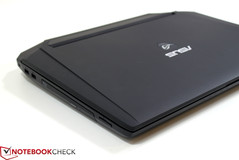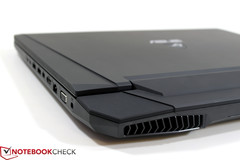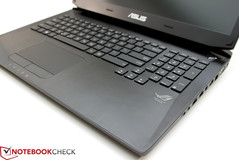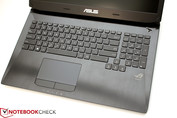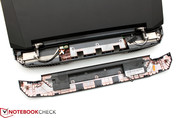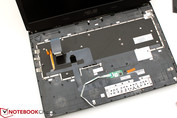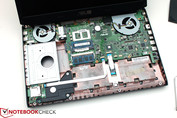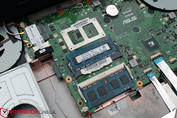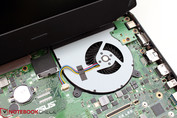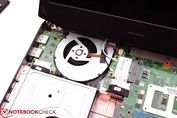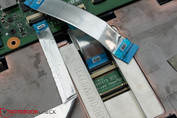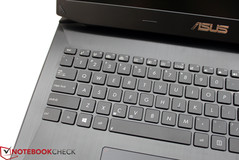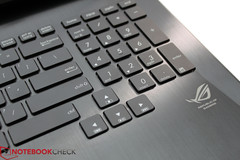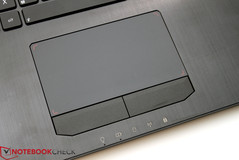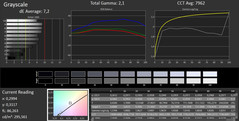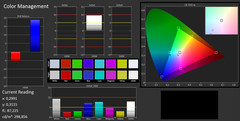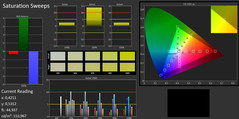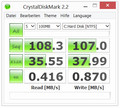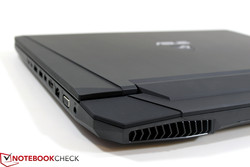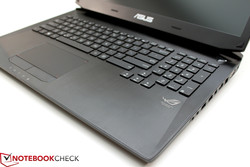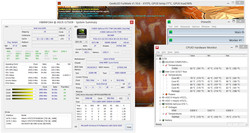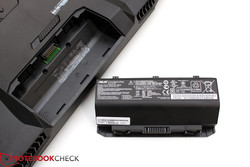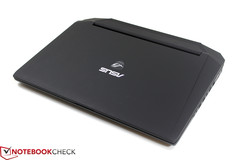Preview Asus G750JX Notebook

For the original German preview, see here.
In 2007, Asus laid the foundation of its gaming activities with the G2 notebook: One of our test samples featured an Intel Core 2 Duo T7400 processor, an ATI Mobility Radeon X1700 graphics cards, 2 GB RAM, and a 160 GB hard drive. Six years passed by and we saw many chip generations. Now we have the Asus G750JX in front of us. It is Asus' 6th generation of 17-inch gaming notebooks and features up-to-date CPU technology, an Intel Core i7-4700HQ "Haswell" CPU and a state-of-the-art GTX 770M graphics card by Nvidia.
We got a pre-production sample from Asus for a first test. So, equipment, integrated components, software and drivers might change before the device is finally launched. Because of the pre-production status, we will not evaluate this test model in detail, but review a final model of the Asus G750JX later.
Those of you that thought the subtle change in the naming is accompanied by a fundamental change of the look, are wrong. Although several details were changed, the G750JX continues the familiar Stealth design. The fan grilles at the back and the trigonometric edges are still striking details. The base unit looks simpler and slimmer than its G75 predecessor's and is completely black. But, with a maximum of about 50 mm, the bulky height only slightly changed.
The surfaces were also subtly changed: The case tray is completely made from black plastic. It is covered by a single aluminum plate, which accommodates the keyboard and touchpad. Dirt and fingerprints sometimes quickly collect here, but it is easy to clean the surface. The lid features the well-known soft touch surface, which is not only nice to the touch, but also rather insensitive to dirt. Already the pre-sample's stability and build quality are good to very good. But, we will wait for the production model for a final judgment.
The Asus G750JX features nearly all the interfaces of its G75VX predecessor including four USB 3.0 ports, HDMI, and a Thunderbolt port. The jacks for the microphone and headphones changed sides and are now on the right side towards the front. Like the G75, the G750JX has many ports in the center or towards the front of the right side. So, connected cables could obstruct an external mouse.
Communication modules
Our pre-sample features a Gigabit Ethernet module from Atheros (AR8171/8175) and an Atheros AR9485WB-EG Wi-Fi module (2.4 GHz band only, 150 Mbit/s). These were already used in the current G75VX model.
Maintenance
A single maintenance hatch allows access to two RAM slots (of a total of four) and the two hard drive slots. All available slots are occupied in our test system. It houses four 4 GB RAM modules and two conventional hard drives with a total capacity of 1500 GB. The maximum RAM capacity is 32 GB. Depending on the slots used in factory state, the two slots, which are not easily accessible to the user, might limit upgrades.
We dismantled the notebook as far as reasonably possible. After removing numerous screws, the aluminum cover of the base unit can be removed and you gain access to the other two RAM slots. In theory, you can also clean the two fans now, but heat pipes and heat sinks are still inaccessible. Asus incorporated the main components like the CPU and GPU on the bottom side of the motherboard. Therefore, it has to be removed if you want to access these. The advantage is that the upper side of the base unit, i.e. the keyboard, is better protected against heating. We can confirm this in our test (see emissions).
Software, accessories, and warranty
As the test device is a pre-sample we cannot make reliable statements here. The G750JX might come with many software tools and a base warranty of 24 month as did its predecessors.
Keyboard
The keyboard is nearly the same as the G75VX's. The most striking change is that the number pad is now closer to the main keyboard. This was made possible by separating the full-sized cursor keys a little more. The keyboard features a back light with three brightness levels, which can also be completely deactivated.
The keyboard is responsive and also passed first gaming tests. Depending on your preferences, the pressure point could be clearer. But, overall the keyboard is decent. It remains to be seen how well the keys can cope with hard gaming use for multiple years.
Touchpad
The touchpad of the predecessor was rather big. Now the size has increased to 117 x 66 mm. Thanks to the smooth surface, keys with clear stroke and the decent responsiveness to multi-touch gestures, an external mouse is not required during office use.
As usual for 17-inch gaming notebooks, Asus uses a 17.3-inch display with a maximum resolution of 1920x1080 pixels (Full HD) in the G750. In addition, the screen has a matte surface, which prevents annoying reflections. Our pre-sample features a screen with the name AUO B173HW02 V1. It remains an open question if the same screen will be incorporated into the devices for retail.
| |||||||||||||||||||||||||
Brightness Distribution: 85 %
Center on Battery: 278 cd/m²
Contrast: 556:1 (Black: 0.5 cd/m²)
ΔE ColorChecker Calman: 5 | ∀{0.5-29.43 Ø4.78}
ΔE Greyscale Calman: 7.2 | ∀{0.09-98 Ø5}
64.8% AdobeRGB 1998 (Argyll 3D)
88.6% sRGB (Argyll 3D)
67% Display P3 (Argyll 3D)
Gamma: 2.1
CCT: 7962 K
The measurements of the pre-series screen are comparable with the predecessor's (G75VX). The average brightness is about 260 cd/m², the decent contrast 560:1. Overall, the values are good, but better screens are available in this category.
Despite pre-production status, we evaluated the color representation of the built-in screen: In gray levels, the display achieves an average DeltaE 2000 of 7.2. Brighter gray levels deviate more from the ideal value than darker ones. The G750 pre-sample performs better in color representation. This is apart from cyan with a DeltaE 2000 of up to 10, while the average DeltaE is 5. Cyan and magenta deviate towards blue and so the displayed image looks slightly bluish. Overall, the image is alright for the average user.
The screen can neither cover sRGB nor AdobeRGB completely. However, this is only important for professional graphic designers and photographers.
Thanks to the matte display surface, the passable brightness, and the good contrast, the Asus G750 can also be used outdoors in theory. However, this scenario is not very likely as the notebook is bulky and relatively heavy.
As already mentioned above, the Asus G750JX is based on the new Intel chip generation called Haswell. The Ivy Bridge successors are processed in 22 nm lithography, but, following Intel's tick tock model they have a new architecture. The resulting performance gain and the new features are covered in a special article at Notebookcheck, which was published upon the official introduction of Haswell. We focus on the system and graphics performance of our Asus pre-sample here.
Processor
Our G750 pre-sample from Asus features a brand-new i7-4700HQ Haswell CPU. In this case, HQ does not hint at the integrated graphics solution (which is just the HD Graphics 4600, not the Iris Pro Graphics 5200), but on the support for vPro and the BGA package. However, the IGP is not active in our Asus G750 anyway, as it only uses the dedicated Nvidia GeForce GTX 770M.
The quad-core CPU increased its clock rate to up to 3.3 GHz during the Cinebench R11.5 single rendering benchmark and achieved a score of 1.47 points. This is about the level of the i7-3520M dual-core CPU or the wide spread i7-3630QM. In the multi-core rendering tests it accomplished 6.93 points and is nearly on par with the Intel i7-3920XM Extreme CPU, which still was the most powerful mobile CPU a short while ago. The 3630QM CPU is about 10% slower in this test.
System Performance
We evaluate the system performance with well-known benchmarks. Subjectively, the system responds quickly. Applications start instantly and booting takes less than 10 seconds.
In the PCMark 7 benchmark our pre-series model achieves 3,550 points. Directly compared to the 4,541 points of the G75VX predecessor (3630QM/GTX 670MX/HDD) the result does not appear to be representative. Because of its significantly more powerful core components, the G750 should actually perform notably better. We assume that this is caused by the not yet final software and drivers of the pre-series model.
| PCMark 7 Score | 3550 points | |
Help | ||
Storage solution
The Asus G750JX features two 2.5-inch hard drive slots. In our pre-sample configuration both were occupied with a Hitachi Travelstar 7K500 hard drive with 750 GB capacity and a revolution speed of 7,200 rpm. So, the total gross hard drive capacity is 1.5 TB. It remains to be seen how the devices for selling will be equipped. We think a possible combination of fast SSD as system drive and big conventional hard drive for data would be attractive.
Let us briefly look at the hard drive benchmarks: the Hitachi HDD can score points in HD Tune with a decent average transfer rate of 103.2 MB/s and an access time of 16.4 ms. It belongs to the faster models of its kind. While it cannot keep up with modern SSDs, it delivers relatively large capacity for a small price.
Graphics card
The Nvidia GeForce GTX 770M is the successor of the GeForce GTX 670MX. Both graphics cards stem from the Kepler generation and are processed in 28 nm lithography. Shader count (960) and video memory (3072 MB) are also identical. But, the GTX 770M uses higher clock rates.
Its core clock is 706 MHz (670MX: 600 MHz) and it features, like Intel CPUs, a dynamic GPU turbo, which can, depending on the cooling reserves, increase the clock rates above this level. We recorded clock rates of up to 862 MHz in our tests. A detailed description of the GTX 770M graphics card from Nvidia is available in our special article. The top model from Nvidia is the GeForce GTX 780M with more shaders (1,536 vs. 960), bigger video memory, and 256-bit memory interface.
Please consider that the results of the following benchmarks stem from a pre-sample not for sale. Final models might use different hardware and drivers, which could have an impact on the result. Our pre-sample came with a preinstalled ForceWare 311.12 driver.
In the Unigine Heaven benchmark, our Asus G750JX test configuration achieved an average of 62.0 fps and is 37% faster than the GTX 670MX (in the Asus G75VX). AMD's HD 7970M performs, depending on the test configuration, 20 to 30% better. Nvidia's flagship, the GTX 780M is 60% faster and wins the performance crown in our ranking of mobile graphics cards (single chip solutions). In the 3DMark 11 Performance score, our test sample achieves 5,066 points and the ranking of the Unigine Heaven benchmark above is confirmed.
| 3DMark 06 Standard Score | 23020 points | |
| 3DMark 11 Performance | 5066 points | |
| 3DMark Ice Storm Standard Score | 109375 points | |
| 3DMark Cloud Gate Standard Score | 14784 points | |
| 3DMark Fire Strike Score | 3131 points | |
Help | ||
Gaming Performance
The most crucial aspect of a gaming notebook is its gaming performance. Once again we have to point out the pre-series status of our test device. In particular the installed drivers, but also the potentially different CPU in the final product might have an impact on the result. So, only a preliminary classification of the Asus G750 is possible.
Let us see how the test device performs in BioShock Infinite (reviewed here). In the benchmark integrated into the game (high graphics quality, 1366x768), the Asus G750 with Nvidia GTX 770M GPU achieves 101 fps. The AMD 7970M (XMG P502 with 3610QM) is 16% faster, the GTX 680M in the same notebook 22%. 1st place: Nvidia GTX 780M in the XMG P703 with +46%. The GTX 670MX (also in the Asus G75VX predecessor) is, with -23%, significantly slower.
We increase the demands on the GPU (1920x1080, ultra). Nvidia's new flagship, the GTX 780M, outperforms our test model by 57% and the two former top models, the 7970M and the 680M are also significantly faster: +56% for the Nvidia GPU and +46% for AMD in the XMG P502 notebook. Interestingly, the distance to the GTX 670MX decreases notably: the predecessor is only 7% slower here.
| BioShock Infinite | |
| 1366x768 High Preset (sort by value) | |
| Asus G750JX | |
| Schenker XMG P703 | |
| Schenker XMG P502 | |
| Schenker XMG P502 | |
| Schenker XMG P502 | |
| Schenker XMG P502 | |
| 1920x1080 Ultra Preset, DX11 (DDOF) (sort by value) | |
| Asus G750JX | |
| Schenker XMG P703 | |
| Schenker XMG P502 | |
| Schenker XMG P502 | |
| Schenker XMG P502 | |
| Schenker XMG P502 | |
Crysis 3 also qualifies well for a comparison as it is a demanding game. With high settings (1366x768, high) the Asus G750 achieves 49.1 fps in our Crysis 3 benchmark run. 1st place: the GTX 780M in the Schenker P703 with +47%. The GTX 680M in the XMG P502 is +5% faster while the 7970M in the same device is -9%, the GTX 670MX -29% and the GTX 660M -47% slower.
At maximum graphics settings (1920x1080, ultra) the ranking is the same as in BioShock. Unchallenged top: GTX 780M with +50%, followed by the GTX 680M with +12% and the 7970M with +4%. The GTX 670MX with -29% and the 660M with -49% are significantly slower. The powerful Haswell CPU of our test model could have a positive impact on the performance with high graphics settings.
| Crysis 3 | |
| 1366x768 High Preset AA:FX AF:16x (sort by value) | |
| Asus G750JX | |
| Schenker XMG P703 | |
| Schenker XMG P502 | |
| Schenker XMG P502 | |
| Schenker XMG P502 | |
| Schenker XMG P502 | |
| 1920x1080 Very High Preset AA:2xSM AF:16x (sort by value) | |
| Asus G750JX | |
| Schenker XMG P703 | |
| Schenker XMG P502 | |
| Schenker XMG P502 | |
| Schenker XMG P502 | |
| Schenker XMG P502 | |
Finally, we compared Far Cry 3 (in-depth benchmark check) in detail. Our G750 test configuration with Haswell CPU and Nvidia GTX 770M graphics card achieves 58.6 fps with high graphics details (1366x768, high) and is on par with the AMD 7970M in the XMG P502. Again the GTX 780M from Nvidia in the XMG P703 is fastest with +36%. Nvidia's GTX 680M in the P502 is about 17% faster. As usual, the GTX 670MX (-25%) and the 660M (-39%) are slower.
If we increase the demands on the GPU (1920x1080, ultra) first place does not change: +45% for the GTX 780M. But, this time the HD 7970M is second for the first time (+22%); Nvidia's GTX 680M follows with +12%. The 670MX and 660M are -34% and -49% slower.
| Far Cry 3 | |
| 1366x768 DX11 High Preset (SSAO, Standard Alpha To Coverage) AA:2x MS (sort by value) | |
| Asus G750JX | |
| Schenker XMG P703 | |
| Schenker XMG P502 | |
| Schenker XMG P502 | |
| 1920x1080 DX11 Ultra Preset (HDAO, Enhanced Alpha To Coverage) AA:4x MS (sort by value) | |
| Asus G750JX | |
| Schenker XMG P703 | |
| Schenker XMG P502 | |
| Schenker XMG P502 | |
| Schenker XMG P502 | |
| Schenker XMG P502 | |
Gaming verdict: The Asus G750 gaming notebook with Nvidia GTX 770M graphics card and Haswell processor ranks in the second line. The GTX 780M, introduced at the same time as the GTX 770M, is, with an impressive +50%, the fastest. The GTX 770M is usually slightly slower than the current top graphics cards, the GTX 680M and the HD 7970M. The GTX 670MX predecessors (e.g. in the Asus G75VX replaced now) are on average outperformed by 25%.
In our tests, many games could be run with native Full HD resolution (1920x1080) and high graphics details.
| low | med. | high | ultra | |
|---|---|---|---|---|
| Battlefield 3 (2011) | 126.4 | 90.7 | 78.2 | 32.6 |
| Assassin´s Creed III (2012) | 76.6 | 72.6 | 30.06 | |
| Far Cry 3 (2012) | 116 | 103.7 | 58.6 | 20.9 |
| Crysis 3 (2013) | 115.3 | 66.4 | 49.06 | 19.55 |
| Tomb Raider (2013) | 266.6 | 146.3 | 95.7 | 40.9 |
| BioShock Infinite (2013) | 195.4 | 117.8 | 101.1 | 29.86 |
System noise
Asus' gaming meteors have always been associated with acceptable noise levels. Given the update of the core components in the G750, it is interesting to see how the system noise developed.
Like in the predecessor, Asus does not use a graphics switch (Nvidia Optimus) in the G750 test model. So, the dedicated graphics card is also active in low load scenarios. While idle, we measure a minimum of 33.6 dB(A) and the noise is clearly audible, but it remains in the background. The G75VX predecessor was slightly quieter here.
As usual the G750 demonstrates its strength under load. In 3DMark06, the noise level is mostly around 36.8 dB(A). Subjectively, the notebook is only marginally louder than during undemanding office use. During the stress test (Prime95 and Furmark) the system reached a maximum noise of 41.4 dB(A). Given the performance, this is still decent. In a realistic test, e.g. a Battlefield 3 session of multiple hours, we measured about 40 dB(A).
To summarize, the Asus G750 shows a familiar behavior. The system could be quieter in idle and low load scenarios. Once again we want to mention that the test sample's status is not final.
Noise level
| Idle |
| 33.6 / 33.6 / 33.6 dB(A) |
| HDD |
| 33.6 dB(A) |
| DVD |
| 37.8 / dB(A) |
| Load |
| 36.8 / 41.4 dB(A) |
 | ||
30 dB silent 40 dB(A) audible 50 dB(A) loud |
||
min: | ||
Temperature
The dual fan system (one fan/heat sink/heat pipe per GPU and CPU) keeps the temperature mostly especially cool. While idle, the upper side of the base unit, i.e. keyboard and touchpad, partly remains significantly below 30 °C. Even the underside only slightly exceeds this level.
We ran the stress test (full load) for multiple hours again and measured the temperature: The maximum temperature was 35.4 °C at the keyboard and the temperature stays below 30 °C at the palm rests. On the underside the temperature increased to a maximum of 46.7 °C towards the back alongside the fan grilles.
During games (Battlefield 3) the temperatures stayed below these values. On the keyboard side the temperature just increased to 32.8 °C, while the underside reached a more than acceptable maximum of 40.1 °C.
Stress test
As usual we ran a stress test for multiple hours. Prime95 and Furmark generate 100% CPU and GPU load and after about three hours we measure the core temperatures and record the clock rates of the two core components. The built-in CPU did not show any signs of thermal throttling and clocked constantly at just under 3 GHz with a core temperature of 83-87 °C. The GeForce GTX 770M graphics card can also constantly use the turbo and clocked at 823 MHz. The temperature measured was about 79 °C (according to CPUID Hardware Monitor). Although this is an extreme scenario, it appears that there are still sufficient cooling reserves for potential upgrades.
(+) The maximum temperature on the upper side is 36.2 °C / 97 F, compared to the average of 40.4 °C / 105 F, ranging from 21.2 to 68.8 °C for the class Gaming.
(-) The bottom heats up to a maximum of 46.7 °C / 116 F, compared to the average of 43.3 °C / 110 F
(+) In idle usage, the average temperature for the upper side is 27.8 °C / 82 F, compared to the device average of 33.9 °C / 93 F.
(+) The palmrests and touchpad are cooler than skin temperature with a maximum of 28.7 °C / 83.7 F and are therefore cool to the touch.
(±) The average temperature of the palmrest area of similar devices was 28.9 °C / 84 F (+0.2 °C / 0.3 F).
Energy consumption
Like its predecessors the Asus G750 does not use a graphics switch. So, the dedicated GTX 770M is always active. In the best case (idle, min. brightness, energy saving module, flight mode) the G750 still requires 22.5 Watt. In comparison: The G75VX only needs 15.4 Watt here. The Schenker P703 notebook (Haswell CPU, GTX 780M) reviewed at the same time is also more frugal with 19.8 Watt in this scenario, but uses Nvidia Optimus. The maximum energy demand of the G750 is 30.6 Watt without load while the P703's is 31.4 Watt.
Under load (3DMark06) the G750 pre-sample needs about 95 Watt. The predecessor (3610QM/GTX 670MX) was also more frugal with 82 Watt here. Schenker's XMG P703 with GTX 780M has a significantly higher energy demand of 128 Watt. The maximum of 164 Watt was recorded during the stress test. The included power adapter has a sufficient capacity of 200 Watt.
| Off / Standby | |
| Idle | |
| Load |
|
Key:
min: | |
Battery Life
The G750 comes with an 88 Wh battery. In absolute terms, the capacity seems respectable, but, the energy consumption of the gamer is quite high and limits the expected battery life. In our first tests of the pre-series model, we recorded a maximum battery life of above 6 hours. In our WLAN test with adapted brightness, the G750 achieves more than 4 hours. So, short trips without the power adapter are possible, but are probably not what potential buyers of the G750 want to do anyway.
With the G750 Asus brings in a new generation again. According to the motto "Never change a running system", the system was only carefully modified. The Stealth look was subtly changed and the device looks simpler and more mature now.
The performance was more deeply changed. Thanks to Intel's Haswell CPU and the new GeForce GTX 770M graphics card from Nvidia, the Asus G750 performs about 25% faster than its G75VX (3630QM/670MX) predecessor in games. The cooling system does not have any problems cooling the built-in components (4700HQ/GTX 770M). There are still sufficient reserves for GPU and CPU turbo during our stress test of several hours.
Although the pre-series model was slightly too loud when idle, its system noise is on par with the predecessor's good level. However, this might improve before the notebook is finally launched.





